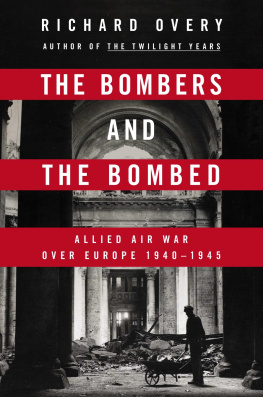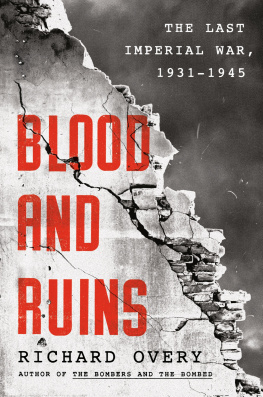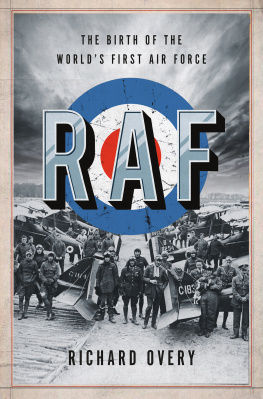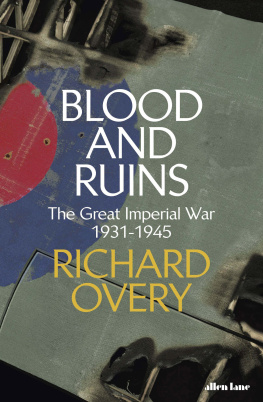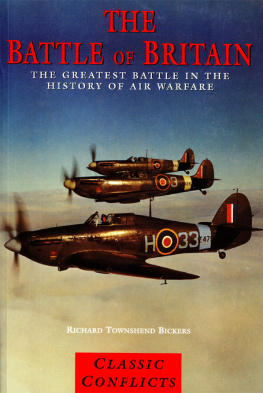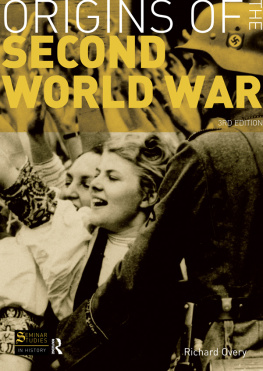ABOUT THE AUTHOR
Richard Overy is Professor of History at Kings College, London. His previous books include Russias War, Interrogations and most recently The Dictators.
ACKNOWLEDGEMENTS
I would like to acknowledge the helpful assistance received in the Imperial War Museum, the Public Record Office, and above all in the Ministry of Defence, Air Historical Branch. I am particularly grateful to Sebastian Ritchie for casting an expert eye over the text at very short notice. I would like to thank Tony Mansell for sorting out figures on casualties, and Richard Simpson of the RAF Museum, Hendon, for help on some technical issues. Simon Winder at Penguin was the inspiration behind the subject and its format. Kate Parker has been a scrupulous editor. Any errors and misjudgements that remain are, as ever, my own responsibility. To Kim, Alexandra and Clementine my love and thanks.
TABLES AND MAPS
THE HURRICANE AND THE SPITFIRE:
PRODUCTION, OPERATIONAL STRENGTH AND LOSSES
Table 1: Production per week, JuneNovember 1940
Date | Hurricanes | Spitfires |
17 June | | |
814 June | | |
1521 June | | |
2228 June | | |
29 June5 July | | |
612 July | | |
1319 July | | |
2026 July | | |
27 July2 August | | |
39 August | | |
1016 August | | |
1723 August | | |
2430 August | | |
31 August6 September | | |
713 September | | |
1420 September | | |
2127 September | | |
28 September4 October | | |
511 October | | |
1218 October | | |
1925 October | | |
26 October1 November | | |
Total | 1,367 | |
Table 2: Operational strength: number of squadrons, JulyOctober 1940
Date | Hurricane squadrons | Spitfire squadrons |
14 July 1940 |
10 Group | | |
11 Group | | |
12 Group | | |
13 Group | | |
Total | | |
1 September 1940 |
10 Group | | |
11 Group | | |
12 Group | | |
13 Group | | |
Total | | |
30 September 1940 |
10 Group | | |
11 Group | | |
12 Group | | |
13 Group | | |
Total | | |
28 October 1940 |
10 Group | | |
11 Group | | |
12 Group | | |
13 Group | | |
Total | | |
Table 3: Operational losses per week, JulyNovember 1940 (aircraft totally destroyed)
Date | Hurricanes | Spitfires |
10 May29 July | | |
30 July5 August | | |
612 August | | |
1319 August | | |
2026 August | | |
27 August2 September | | |
39 September | | |
1016 September | | |
1723 September | | |
2430 September | | |
17 October | | |
814 October | | |
1521 October | | |
2228 October | | |
29 October4 November | | |
Total | | |
(as percentage) | 61.7 | 38.3 |
Sources:
Table 1: PRO AIR 22/293, Weekly Output of Fighters.
Table 2: PRO AIR 16/365, Fighter Command, Operational Strength of Squadrons and Order of Battle.
Table 3: PRO AIR 22/262, Daily Returns of Casualties to RAF Aircraft, 25 June29 September 1940.
SINGLE-ENGINED FIGHTER PILOT STRENGTH,
RAF AND GERMAN AIR FORCE
Table 1: Fighter Command pilot strength
Week ending | Establishment | Operational strength |
30 June 1940 | 1,482 | 1,200 |
27 July 1940 | 1,456 | 1,377 |
17 August 1940 | 1,558 | 1,379 |
31 August 1940 | 1,558 | 1,422 |
14 September 1940 | 1,662 | 1,492 |
28 September 1940 | 1,662 | 1,581 |
19 October 1940 | 1,714 | 1,752 |
2 November 1940 | 1,727 | 1,796 |
Table 2: German Air Force, single-engined fighter pilot strength
Date | Fully operational pilots |
1 June 1940 | |
1 August 1940 | |
1 September 1940 | |
1 November 1940 | |
Sources:
Table 1: PRO AIR 22/296, Personnel: Casualties, Strength and Establishment of the RAF.
Table 2: C. Webster and N. Frankland, The Strategic Air Offensive against Germany (4 vols, London, 1961), vol. 4, p. 501; W. Murray, Luftwaffe: Strategy for Defeat 19331945 (London, 1985), p. 54. For September, Webster and Frankland give a figure of 688 operational pilots.
includes 2 half-strength squadrons
includes 1 part-strength squadron
THE SETTING
We have reason to believe that Germany will be ruthless and indiscriminate in her endeavour to paralyse and destroy our national effort and morale and unless immediate steps are taken to reduce the intensity of attack it is conceivable that the enemy may achieve her object.
AIR MINISTRY MEMORANDUM, APRIL 1938
For most of the 1930s Britains politicians and military leaders were haunted by nightmare visions of a massive knock-out blow from the air against which there could be little defence save the threat of retaliation. When Neville Chamberlain, Britains prime minister from 1937 to 1940, flew back to London from Germany at the height of the Czech crisis in 1938, he looked down at the sprawling suburbs of the capital and imagined bombs crashing down upon the innocent victims below him. This horrible picture inspired him to redouble his efforts for peace. A year later, on 3 September, those efforts were finally undone. Britain declared war on Germany for her refusal to withdraw invasion forces from Poland, whose sovereignty Chamberlain had guaranteed five months before.
Next page


